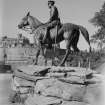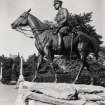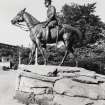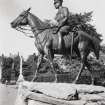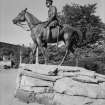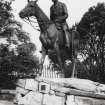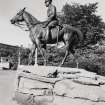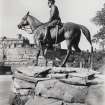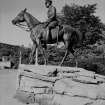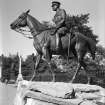Edinburgh Castle, Hospital Square, Statue Of Earl Haig
Statue (20th Century), War Memorial (20th Century)
Site Name Edinburgh Castle, Hospital Square, Statue Of Earl Haig
Classification Statue (20th Century), War Memorial (20th Century)
Canmore ID 236873
Site Number NT27SE 1.52
NGR NT 25049 73524
Datum OSGB36 - NGR
Permalink http://canmore.org.uk/site/236873
- Council Edinburgh, City Of
- Parish Edinburgh (Edinburgh, City Of)
- Former Region Lothian
- Former District City Of Edinburgh
- Former County Midlothian
See also, NT27SE 1.33 Castle Esplanade
Project (1997)
The Public Monuments and Sculpture Association (http://www.pmsa.org.uk/) set up a National Recording Project in 1997 with the aim of making a survey of public monuments and sculpture in Britain ranging from medieval monuments to the most contemporary works. Information from the Edinburgh project was added to the RCAHMS database in October 2010 and again in 2012.
The PMSA (Public Monuments and Sculpture Association) Edinburgh Sculpture Project has been supported by Eastern Photocolour, Edinburgh College of Art, the Edinburgh World Heritage Trust, Historic Scotland, the Hope Scott Trust, The Old Edinburgh Club, the Pilgrim Trust, the RCAHMS, and the Scottish Archive Network.
Field Visit (25 September 2002)
Bronze equestrian statue of Field Marshal Earl Haig. Earl Haig is dressed in his uniform and has his sword attached to the back of the saddle on the near side. He holds the reins with his left hand and rests his right hand on the top of his right thigh. His horse has his head up and his ears pricked. The statue stands on a rocky base.
Commissioned by Sir D. Bomanji and offered as a gift to Edinburgh Corporation. Unveiled by the Lord Provost 28 September 1923, when the statue was officially taken over by the Corporation. Responsibility for the statue was then allocated to the Lord Provost's Committee. The descriptive bronze plaque was added in 1935. In 1954 the sculptor's name was engraved on the near hind hoof of the horse, after a request from his daughter Miss E. Wade.
Inspected By : T.S.
Inscriptions : On bronze plaque on rocky base (S. side) in raised letters:
EARL HAIG / THIS STATUE WAS PRESENTED / TO THE CITY OF EDINBURGH / BY SIR DHUNJIBHOY BOMANJI / OF BOMBAY / IN ADMIRATION OF THE SERVICES / RENDERED TO THE BRITISH EMPIRE / BY THE FIELD MARSHAL
Signatures : On horse's near hind hoof (in incised letters):
GEORGE WADE / SCULPT. 1922
Design period : 1922-1923
Year of unveiling : 1923
Unveiling details : 28 September 1923. Unveiled by the Lord Provost
Information from Public Monuments and Sculpture Association (PMSA Work Ref : EDIN0478)
Excavation (December 2009 - September 2011)
NT 2530 7350 (centred on) A series of Scheduled Monument Consents (SMCs A–E) were granted, December 2009 – September 2011, for work associated with the design of new temporary stand for the Royal Edinburgh Military Tattoo.
SMC A: Existing utilities were realigned or replaced to accommodate new stand foundations. These works revealed part of the Spur, a triangular artillery fortification built in the 1540s and demolished in 1650. Part of a second boundary-type wall was revealed to the NE of the Spur and this overlay an infilled ditch. The corner of a building was revealed at the E end of the Esplanade. All of these remains may be shown on an Edinburgh plan drawn by Gordon of Rothiemay in 1647. At the top of Castle Wynd Steps, a massively built stone plinth may have been a part of the Esplanade wall which was demolished prior to 1780.
SMC B: The Scottish Horse Monument was dismantled and rebuilt on a new abutment projecting from the North Esplanade Wall. A photographic survey of the wall was carried out.
SMC C: This covered the erection of the new stands and had no archaeological significance.
SMC D: The statue of Earl Haig and its stone plinth were moved from the Esplanade to Hospital Square. Excavations in Hospital Square revealed the wall of the 1748–54 powder magazine and the blast wall to the E.
SMC E: Work to relocate utilities serving the castle took place in Princes Street Gardens, in the Moat Vault, in the Coal Yard and on the steep grass slope between the South Esplanade Wall and Johnston Terrace. Walls were recorded prior to the placement of pipes/ducts. No archaeological remains were recorded in Princes Street Gardens. In the Moat Vault, plinths associated with former arched vaults were recorded. In the Coal Yard, a buried wall was recorded. Between the South Esplanade Wall and Johnston Terrace, a stone revetment was recorded.
Additional non-SMC work took place in Castlehill, Ramsay Lane and Mound Place. In Ramsay Lane, the foundations of what may be tenement buildings were recorded and to the N, part of a culvert drain was recorded.
Archive: City of Edinburgh Council SMR and RCAHMS
Funder: Sir Robert McAlpine on behalf of Royal Edinburgh Military Tattoo Ltd
Information from Ian Suddaby (CFA Archaeology Ltd) 2012. OASIS ID: cfaarcha1-78685
Note (2011)
The statue of Earl Haig was moved from the Esplanade of Edinburgh Castle to Hospital Square in 2011.
Information from HES (SIH), 29 January 2019



















